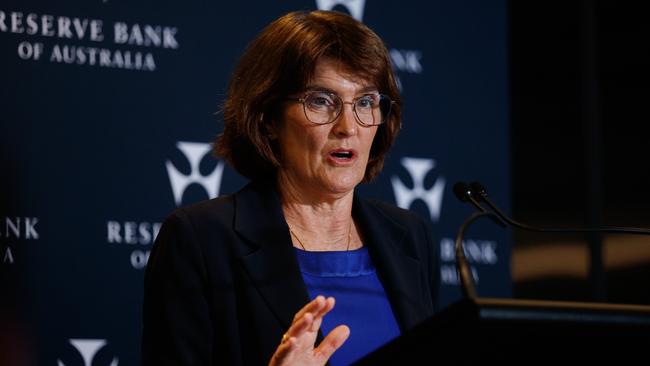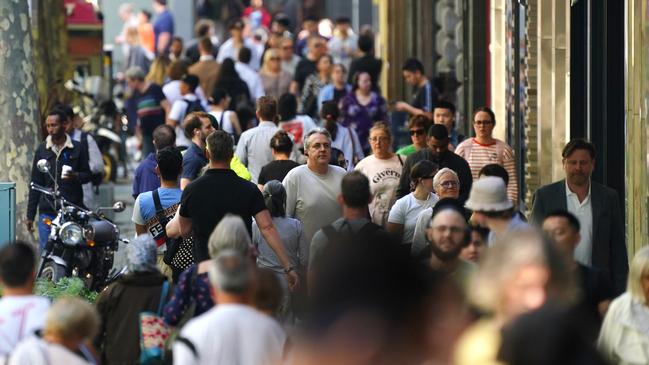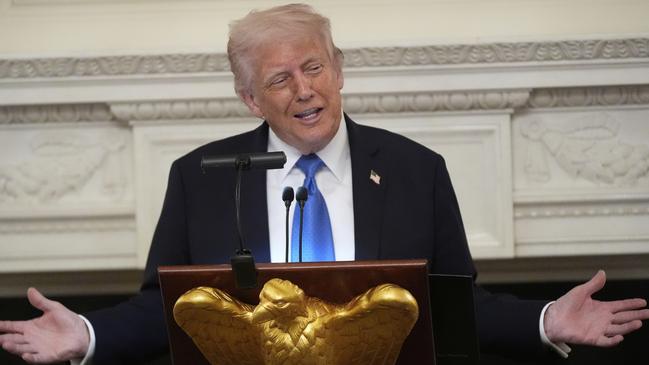RBA rate decision: Two down, three to come? Central bank on the verge of an inflation win


Michele Bullock’s new-look Reserve Bank delivered its widely-expected cut on Tuesday and in a welcome surprise, she is on the verge of declaring victory in the fight against inflation. However, the sting in the tail is the win on softer inflation is largely (although not entirely) thanks to Donald Trump unleashing his trade war and hurting the outlook for the global economy, and this means slower growth for Australia.
If all goes to plan, Australia will have a different feel this time next year, with a cash rate tantalisingly close to having a “2” in front of it, with inflation almost bang-on target. Combined this will deliver more cash into the hands of those who need it most and a stable inflation outlook gives a much-needed shot in the arm for business confidence.
In other words, the soft landing is all Bullock’s to deliver.
“I don’t want to sort of suggest that I’m 100 per cent confident that we’re there, but it is really encouraging that we’ve managed to get inflation down, and we still have employment holding up,” the RBA governor says.
However, don’t bank on this goldilocks scenario arriving just yet.
The local jobs market picking up again represents a risk to inflation, and there are still plenty of erratic policy calls coming out of Donald Trump’s White House.
The big Trump unknown is how his tariff negotiations will land and this has the potential to deliver a global shocks and flow on to slower growth for Australia.
The outlook is not just uncertain, “it’s actually unpredictable,” she says.
The RBA is clearly very worried about the impact of tariffs on the world economy and this prompted it to resume its practice of running a scenario analysis in considering big external economic shocks.
This time it considered three alternatives in shaping its forecasts. These ranged from a world tariff escalation; the tariff holding patten that we have now; to a swift resolution of US trade negotiations.
Subtle shift
Bullock’s RBA hit the brief with a 25 basis points cash rate cut as a reward for our efforts, so far, in getting inflation down to the top of the target. This was “confident cut”, and leaves the door open for more. The board even introduced the idea of a monster 50 basis point cut, as National Australia Bank was tipping, although around the central bank’s boardroom this wasn’t a strong argument.
Bullock too subtily shifted the bank’s war footing from “sustainably returning” inflation to its target band to one of “maintaining low and stable inflation”. That’s as good as code as the job largely done.
The move takes the official cash rate below the 4 per cent mark, which has emerged as a key pain threshold for borrowers. Today’s cash rate returns to a more breathable 3.85 per cent, a rate not seen since May 2023. Each of the big four banks promised to pass on the cut in full, although households will have to wait until the end of the month to see the difference.

Going into Tuesday’s cut, economists had been tipping the RBA to slice 100 basis points off the cash rate in this easing cycle, including the cut we had in February. This would put the cash rate at 3.35 per cent. After Tuesday meeting and statement the same economists were adding one more cut to their outlook.
The next round of cuts are expected for August and November. The bonus cut could follow by May next year, taking the cash rate to 3.1 per cent.
There are now two big factors that could influence the pace of future rate cuts.
The first is the hot jobs market, and further fast growth here could stoke inflation again.
Jobs growth smashed expectations in April when the participation rate jumped. Net employment surged by 89,000 positions in April from March, ABS figures showed.
The other swing factor is the global economy and the still live prospect of escalating tariffs is set to weaken global growth, although this is deflationary for Australia.
Even after Tuesday’s move, Australia remains at the upper end of developed country cash rates. The euro zone is at 2.4 per cent, Canada at 2.75 and New Zealand at 3.5 per cent.
The UK cut its rate earlier this month to 4.25 per cent while the US and what it does with Trump’s tariff inflation continues to be the big unknown hanging over the world as the midpoint cash rate there is at 4.5 per cent.
The March quarter CPI put underlying inflation at 2.9 per cent, just inside the RBA’s target of 2 to 3 per cent. The RBA is now tipping inflation will fall to 2.6 per cent, a fraction above the midpoint. Previously it was anticipating a figure closer to 2.7 per cent.
Consumer is king
The cut will be welcomed by business. The story of Australia today is very much a multi-speed economy. Consumers and households are feeling the strain from tighter financial conditions and are cautious, where business conditions have been more robust although increasingly worried about tariffs.
However, consumer demand, through household spending, is important to get firing given it accounts for more than 50 per cent of GDP. The RBA was previously tipping the economy to grow at 2.4 per cent by December where it is now tipping 2.1 per cent. Unemployment is set to edge up higher than anticipated, taking some pressure off wages growth. It’s going to be slower all around to be sure, but still a long way from recession conditions.

There are real soft spots for the economy. A March quarter update by the Commonwealth Bank – the nation’s biggest lender – showed a small uptick in lending losses, particularly across credit cards and personal loans.
It’s still from a low base, however it goes against the notion that Australia emerged from the woods following February’s rate cut.
This suggests there’s a long and painful tail for some after having rates sit at 4.35 per cent for all of last year.
“As we saw throughout calendar 2024 and into the start of this year, obviously, households continue to be under a lot of pressure from cost of living,” Commonwealth Bank chief executive Matt Comyn told The Australian ahead of the RBA decision.
“We expect that will improve over the course of the year, as both inflation reduces and also the effects of rate reduction start to flow through the economy. Hopefully there’s a pick up in consumer confidence and demand, and we can get back to a slightly stronger growth profile”.
National Australia Bank, the nation’s biggest business lender, says the stress points in lending have been around hospitality, construction, manufacturing, while transport is also feeling the squeeze.
The RBA’s almost pulled off an inflation miracle. It’s held unexpected help from Trump, and there are real risks on the horizon. However The central bank has the capacity to really cut if the economy needs a boost.
Bullock says the next year will be a “really interesting time” and she’s not wrong. The Trump trade war represents “a completely different shock”, At least the monetary starting point going into the shock will be much stronger.
johnstone@theaustralian.com.au





Two down, another two more to go. Three, if our luck holds up.